Standing up to sexual assault
Researchers seek to transform a generation in Kenya
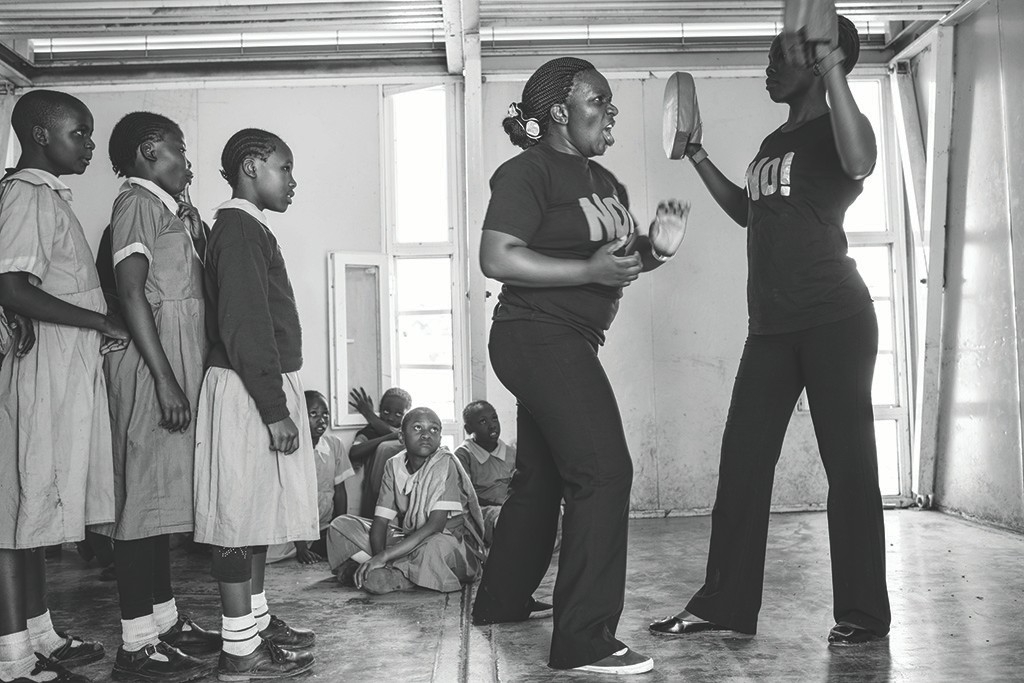
“What makes you a girl?” The question comes out with a flamboyant roll of the “r,” and the young Kenyan teacher with pink-highlighted hair captures the attention of chattering school-age girls. Bashful, some hide their faces and giggle. Others shoot their hands up to answer. “Breasts,” says one little girl earnestly. “Buttocks!” shouts another. The teacher calls on a third student, who primly states, “I was going to say hips, but it’s almost the same thing as buttocks.”
These fourth- and fifth-graders in Nairobi, Kenya, are just the latest in a cohort of students learning how to ward off sexual assault in their impoverished communities. The self-defense training is the focus of a collaboration between Stanford researchers and three nongovernmental organizations to carry out the largest and most rigorous randomized trial ever conducted of an empowerment and self-defense program to prevent sexual assault.
The challenge for the trainers and the researchers is vast: Surveys by national organizations reveal that as many as 46 percent of Kenyan women experience sexual assault as children. A parallel training for their male peers simultaneously seeks to halt a striking pattern: 52 percent of perpetrators are the boyfriends of the girls they rape. A sexual violence prevention group based in Nairobi estimates that only 10 percent of attacks are carried out by strangers.
Elizabeth was 9 years old when she was raped the first time. Two cousins, a boy and a girl, had moved in with Elizabeth’s family when their father died. One day, Elizabeth left the house with the 13-year-old boy to find firewood. “This cousin of mine grabbed me and pushed me down. Then he raped me,” she says, staring straight ahead. “I didn’t share with anyone,” says Elizabeth, who is now a trainer in the self-defense program the Stanford team is studying.
“I was feeling it was just normal for any girl, any woman.” He attacked her again a month later while Elizabeth’s mother was out of the house, and this time the boy’s sister caught him. “When my mother heard, she just took the boy to our grandma. She just removed him from this house to another house, but nothing else happened. She left it at that. So we just lived like that. No punishment. Nothing.”
More than 20 years later and with daughters of her own, Elizabeth survived another rape. She was working as a housekeeper in the home of an older man, who tricked her into one of the bedrooms by saying he would leave her payment there when she finished cleaning. When she went into the room, he slammed the door and pinned her on the bed. “I was so furious. But I felt like, ‘How can I tell people about this? I’m a woman with children. How can I be talking about this rape?’ ”
Although she tried to suppress the trauma, the buried emotions came tumbling out one night when a stranger tried to attack her while she was showering at what she calls the “shanty bathroom,” a public shower that residents use for a fee. “This time I screamed, and I was shaking everywhere,” Elizabeth says. “Some women came to my rescue and asked me, ‘What is the problem? Why are you shaking so much and this man has not even raped you yet?’ That’s when I opened up and told them it’s because this has happened to me before. It was common in our community, so those women felt like it’s just normal.”
Nairobi, the largest and most cosmopolitan city in East Africa, has in many ways epitomized the narrative of a continent on the rise, with its tech startups and influx of international companies. But the city also has a gaping divide between rich and poor. Ramshackle slum neighborhoods teem with hundreds of thousands of people struggling to make a daily wage. They get by with little government effort to drain sewage, collect garbage or combat crime. Asked about root causes of the sexual violence epidemic in her community, Elizabeth points to the police, whom she says can easily be paid off to side with the perpetrators.
So the little girls in their lavender-striped school dresses — and the mothers and grandmothers who raise them — cope with severe rates of sexual violence seemingly without recourse.
But that’s precisely the impression that the group No Means No Worldwide is working to combat. In Kenya, girls may face deep patriarchy and a murky justice system, but with their voices — and sometimes a well-landed elbow jab — they’re powerful beyond their size and age.
‘Some women came to my rescue and asked me, “Why are you shaking so much and this man has not even raped you yet?” ’
No Means No’s six-week empowerment and self-defense program seeks to quash the idea that girls should be obedient and soft-spoken, even when facing a potential attacker. Dynamic trainers — like Elizabeth — teach and model a curriculum that preaches self-worth, starting with feeling confident in their changing bodies. “Just raising the spirit of the girls has enabled them to be able to overcome assault, to feel that something can be done about rape,” says Esther Nyambura, another self-defense trainer, who has worked with No Means No for five years. The students practice screaming, calling out the behavior by name (“That guy in the green shirt just touched my buttocks!”), lying or acting crazy, learning that their first line of defense is to get away.
They’re also taught tactics to use when the attacker is someone they know, like their boyfriend, teacher or uncle. “We tell them that the assailant wants them to keep a secret,” Nyambura says. “By letting the assailant know that someone else knows about this, it can really stop the assault.”
Many of the trainers grew up or still live in the slums where they now lead workshops. “I come from Korogocho, and I know the challenges of Korogocho,” Nyambura says, referring to a neighborhood that borders the country’s largest landfill.
In her previous job as a preschool teacher, Nyambura was startled to hear the experiences her young students recounted without inhibition during morning circle time. Those impressions and the work she does now with No Means No Worldwide have led her to conclude that the high rate of sexual violence stems in part from the way girls are socialized. She says girls are taught, “You have to be nice to everyone, even strangers, even if you’re being assaulted. We’ve had cases where we say, ‘Who did you tell?’ And the last people that the girls tell are their parents. Almost 90 percent don’t tell their parents, because their parents will be like, ‘Shh! Shut up. No one should know this.’ If your dad is jailed, who’s going to pay your school fees, who’s going to pay your rent?”
The expectation that girls don’t have the right to fight back, protest or even speak up about an assault combines in devastating ways with the entitlement boys are taught they have to girls’ bodies. Nyambura says that when male activists in her organization have asked boys why they assault women, “some of them did not know that they’re doing anything wrong. They say things like, ‘What’s the big deal? I’m having fun.’ Most girls are not raped at gunpoint or with a knife — no. They’re coerced, threatened, groomed toward behaving in a certain manner. It’s really about the social norm, which is why we’re targeting kids at a young age. As the boys mature they’ll know how to respect women and the girls in their life and even intervene if they see someone being assaulted.”
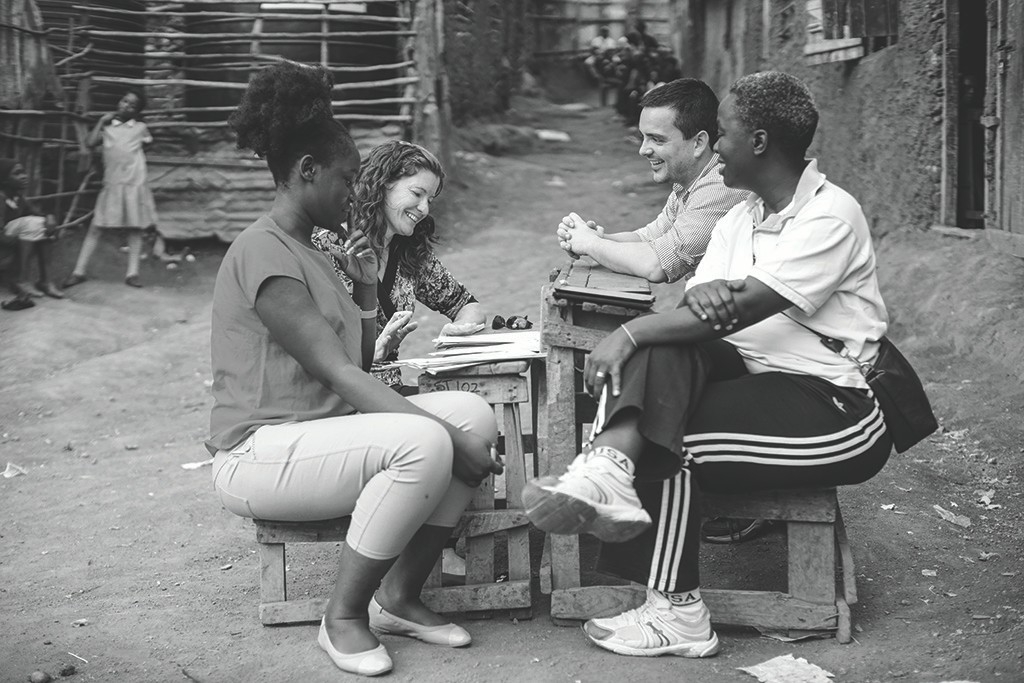
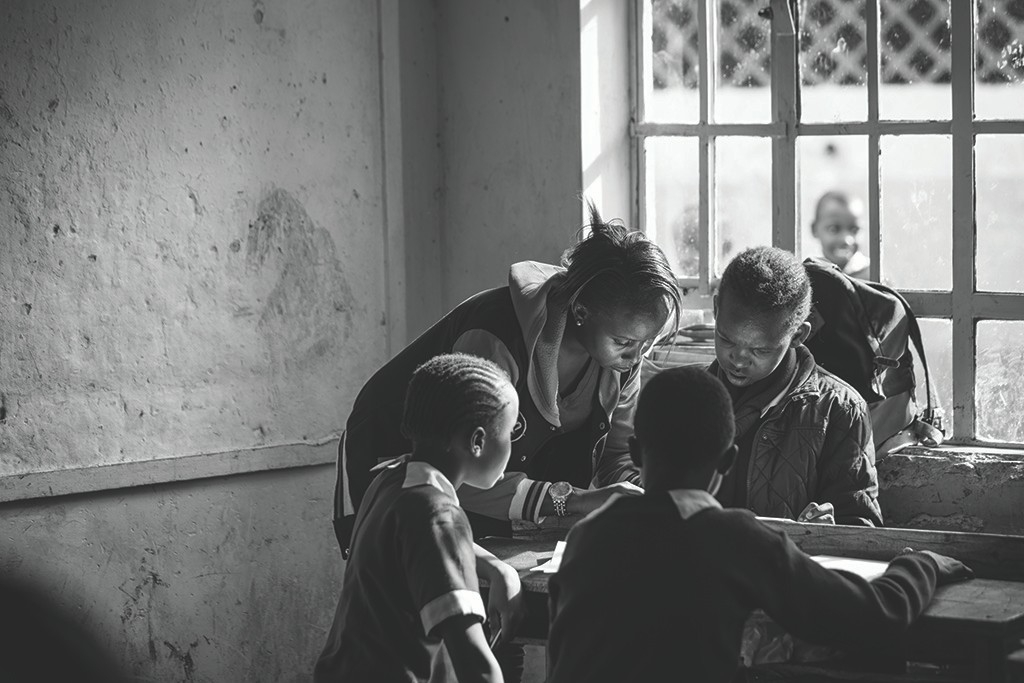
Ever since No Means No Worldwide began its Kenya trainings in 2010, working alongside local partner organization Ujamaa (“togetherness like family” in Swahili), the team has collected ample anecdotal evidence from testimonies and surveys that suggest a powerful impact.
Lee Paiva, the San Francisco-based founder of No Means No Worldwide, says she had been working on an earlier iteration of the training when the question of effectiveness suddenly loomed large. She was in the midst of fundraising and had gotten used to citing the number of participants who had gone through the training. “This little still voice inside of me said, ‘What did you teach them?’ I just really wondered about that. What did those kids actually get? What is that money really going to do? And in that moment I knew — I’m not doing this anymore until I absolutely know what that child got out of this.”
Paiva’s husband, Jake Sinclair, MD, a Bay Area physician and the founder of Ujamaa, approached Stanford faculty members — Yvonne Maldonado, MD, professor of pediatrics and of health research and policy; Neville Golden, PhD, professor of pediatrics; and David Cornfield, MD, professor of pediatrics — about analyzing the data and building upon it to tease out the tangible effects of the program. They launched the Stanford Gender-Based Violence Prevention Collaborative, which is now spearheading the most rigorous and expansive study ever conducted of a behavior-based sexual assault prevention program. The two-year assessment is funded by UKAID as part of the British government’s What Works to Prevent Violence Against Women and Girls Programme, a multi-country, multi-intervention set of studies.
The Stanford prevention collaborative has already conducted several pilot evaluations of the program and come away with striking results. A study published in 2014 in Pediatrics found that more than half of the 1,978 high school-aged girls who had completed the self-defense course had used the skills to fend off sexual harassment or rape. Further, researchers found that the rate of rape dropped during the time the girls were participating in the training: When the study began, about one in five of the girls reported being forced to have sex during the previous year. By the end of the study period, the rate had fallen by more than a third.
The survey also revealed a dramatic difference in the likelihood a girl would report an attack. In the “standard of care” group — girls who didn’t receive self-defense training — about half of those who had been abused told someone about the incident. But among the girls in the training, 75 percent said they spoke up, generally to a friend or relative.
‘As the boys mature they’ll know how to respect women and the girls in their life and even intervene if they see someone being assaulted.’
This past January, Stanford Gender-Based Violence Prevention Collaborative members Clea Sarnquist, DrPH, the 2014 study’s lead author and a senior research scholar in pediatrics, and Michael Baiocchi, PhD, traveled back to Kenya to launch the most ambitious evaluation of the program yet. Baiocchi, an assistant professor of medicine at the Stanford Prevention Research Center, is its principal investigator.
A statistician, Baiocchi specializes in causal inference — analyzing “real-world, messy data where you’re still trying to prove the cause-and-effect relationship,” he says. He and the research team have designed a closed-cohort study that, unlike previous evaluations, will track changes in a fixed group of about 4,000 girls. (Earlier studies homed in on specific classrooms but didn’t track who was interviewed over time.) In this larger, more rigorous study, behavior trends can be traced and analyzed, leading to better understanding of how girls are adapting to the trainings and their social situations.
“You can put together numbers from data collected observationally, but people can doubt the links you’re drawing,” says Baiocchi. “By doing an actual randomization, following people through time and doing really careful measurements, your conclusions are much more solid.”
Donors are eager to see this level of exactitude, to know the kind of impact they can expect from the projects they pay for, Baiocchi says. As the development and humanitarian fields mature, it’s no longer seen as responsible to simply give things away, because untested interventions are both financially unwise and prone to spark unintended consequences in the communities that the projects aim to help. “So this is the highest level of rigor, the equivalent of what it would take to get through the FDA,” Baiocchi says.
In the summer heat this past January, a veteran team of Kenyan researchers and data collectors gathered with Baiocchi and Sarnquist in a Nairobi hotel before fanning out across the city to start collecting the baseline data. Banquet tables were dotted with coffee cups and mint wrappers — fuel for several days of intensive discussions to refine the survey and prepare for data collection in the schools.
Over the following months, when the researchers arrive at the schools with the questionnaires, they would have just under two hours — a school administrators’ rule — to gather the rambunctious 11- and 12-year-olds, have them select colored beads from a hat to randomly determine who would participate, and then have them sit quietly and answer 14 pages of questions. The children would also need to sign an assent form to acknowledge that their involvement is voluntary. Adding to the feat is the reality that many of the students have low levels of literacy, despite being in school.
While debating the plan, the Kenyan researchers raised concerns arising from their work on previous surveys: Some parents might be wary about having their daughter stay after school to answer questions, or they may expect to be compensated for participating. Better to collect cellphone numbers not only for the child’s own family members but neighbors as well; phones get stolen or lost, and people move.
“The attrition rate could be around 25 percent, according to some studies already done,” says Mary Amuyunzu-Nyamongo, PhD, founder and executive director of the African Institute for Health and Development, which is partnering with Stanford to lead the field research. “We may lose some of the children [to follow-up] because they move between slums, between informal settlements and rural areas.”
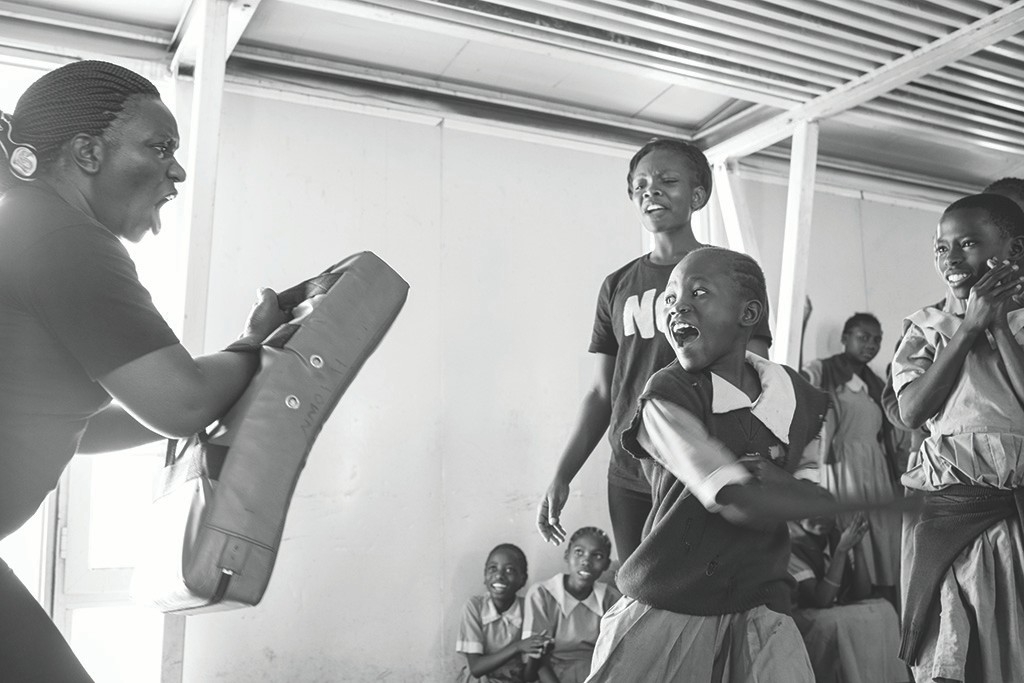
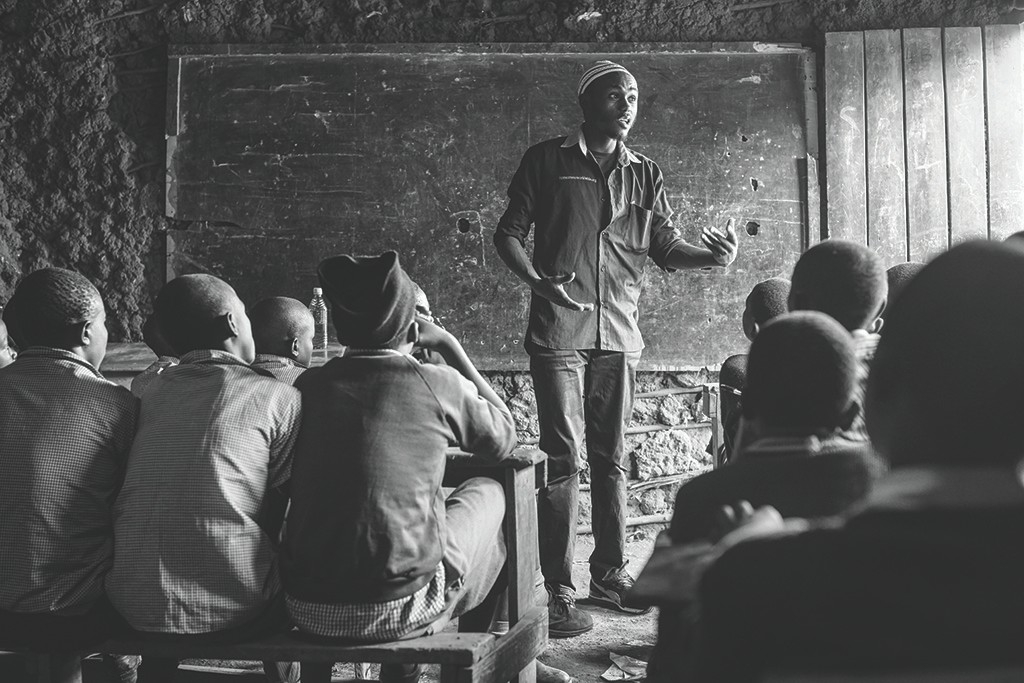
Logistics aside, the content of the questionnaire is sobering, if entirely relevant for capturing the range of hardships these children face day to day. “In the last four weeks, how many times did you go to sleep without dinner because of lack of food at home?” “In the past 12 months how many times did two or more men or boys force you to have sex with them at the same time against your will?” Choose between never, once, two to three times and four or more times.
Even among the data collectors, some of the questions — read aloud during the discussion session — hang in the air. “If 25 percent of Kenyans have been abused, that means that 25 percent of the people sitting around this table…,” Amuyunzu-Nyamongo’s voice trails off. She notes the importance of offering support services even to the researchers. “There’s one who came up and said, ‘I wish I had known this before, because I’ve gone through an experience like this.’ ”
Watching these various teams at work — the data collectors huddled with groups of students in rumpled uniforms, all heads bent over the survey; the Stanford researchers quietly observing from kid-sized wooden benches as their project, months in the design phase, unfolds in the real world; the trainers whose enthusiasm and confidence dares girls to shout, “Hands off my body!” with conviction — it’s apparent that dedication to the broader mission runs deep.
“I’ve seen grannies be able to fight back against rape just by having an awareness to speak up about what’s happening to them,” says Nyambura, the trainer. “They need to believe that they’re worth defending and something can be done. Women have done this before and prevailed.”
Stanford statistician Baiocchi agrees that the shift from lack of agency to a sense of control may be the most powerful element of the trainings. “One of our beliefs is that part of the reason that rape is occurring is because the girls don’t feel like they can change what happens to them,” he says. “We’re monitoring how those perceptions change, because we want to see whether the girls who we help with self-efficacy are the people who have the biggest change when it comes to rape.”
For Lee Paiva, No Means No Worldwide’s founder, the work is profoundly personal. “There are so many different ways of being a survivor,” she says. “My survivorship has allowed me to, in many ways, experience what I experienced and get up and be a voice. Because not everybody can.”
When she was 16 years old, Paiva was sexually assaulted by an acquaintance while sleeping in the living room in a house full of people. “I remember thinking I didn’t want to wake anybody up! I didn’t want to trouble them!” She started taking self-defense classes because she wanted to learn to fight back. But she came away with a new confidence not just grounded in the physical skills but from believing her instincts. “I just needed to know that it’s OK to do what I want to do in that situation, which is scream, yell, call out to people, really fight him, push him off of me.”
More than half of the girls who had completed the self-defense course had used the skills to fend off sexual harassment or rape.
Paiva’s own evolution informs a tenet of the No Means No trainings: “We’re starting at a baseline with understanding that just because the culture might say it’s OK, just because it has been happening for so long… You know how it feels when it happens to you, and you want it to stop. Period.”
Teaching physical tactics to schoolchildren has met some criticism from those who claim that fighting back may make girls more vulnerable during an assault or even aggressive in other contexts. The Stanford researchers say, however, that when tested — mostly among college-age American and Canadian women — those theories have proven unfounded. The research team believes that knowing how to fight back, even if the victim doesn’t have to, is empowering. “In our previous surveys, most girls didn’t get to the physical skills. Most used verbal skills under attack situations,” Sarnquist says. “But we believe that having those physical skills to back them up probably does make girls much more assertive and strong on the verbal skills.” Ultimately, many of the key questions in these debates are empirically testable, and that is what the Stanford team plans to do.
Talking about rape, asking, “What could you do if you face a drunken assailant?” of a classroom of 11- and 12-year-olds, could seem harsh. But it’s not too early, research shows. “The goal is to get to them before, while they’re still at this 7 percent annual incidence rate, not at this 18 to 25 percent annual rate,” says Sarnquist. “The hope is that you give them this training, you give them lifelong skills, so that as they’re entering the highest-risk ages — 12, 13, 14 years old — they already have these skills in hand.”
Down the hallway from the girls, the still-high-pitched voices of their male peers ring out, “The REST of my life can be the BEST of my life only if I make it!” The boys recently started a new curriculum, Source of Strength, that pairs with the girls’ training. (Stanford’s research team has set aside some funding to run an initial assessment of the boys’ program.) “What we do is help boys face the violence in their lives squarely,” says No Means No founder Paiva. “Boys tell our trainers: ‘How do I live my life to avoid getting hurt by somebody bigger, older or in authority?’ Our goal is to help boys get through these formative years without adopting the entitled attitudes and behaviors, the negative gender norms storming their lives at this age and the ‘violence as power’ paradigm.”
Most sexual violence prevention curricula for boys are designed for college-age men or perhaps high school students, says Sarnquist, the Stanford researcher. Focusing on primary-school boys is “unusual and innovative.” The new training is less about bystander intervention and more about empowering boys by emphasizing their agency. “The most important point is that it plays on their strengths. So it’s this positive spin on what it means to be a man, to become a man, and tries to install pride in masculinity.” She says that the No Means No team views this approach “almost like a vaccine.”
That emphasis on empowerment is the heart of the work with both the boys and the girls, and it’s the feature of the program that most animates the Stanford researchers. By learning at an early age to protest abusive behaviors, a generation can grow up to expect and enforce new norms. Sexual violence won’t be wholly stopped by this intervention, Sarnquist and Baiocchi acknowledge. But a dramatic shift is possible and, as early research suggests, already underway. “What a win that is for the community,” says Baiocchi. “Because the change is being powered from within, these girls and boys are changing what’s considered OK.”

